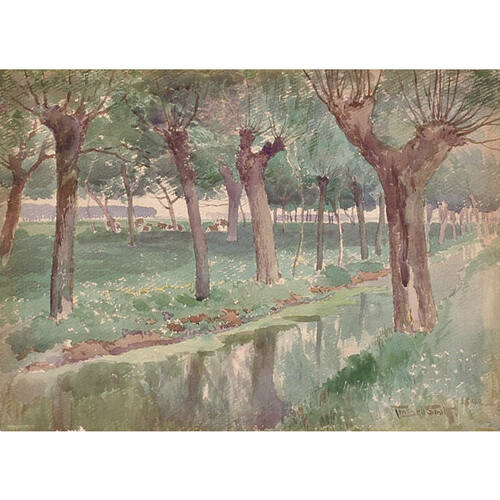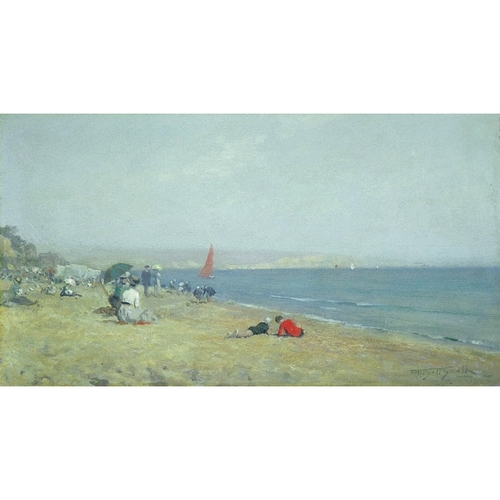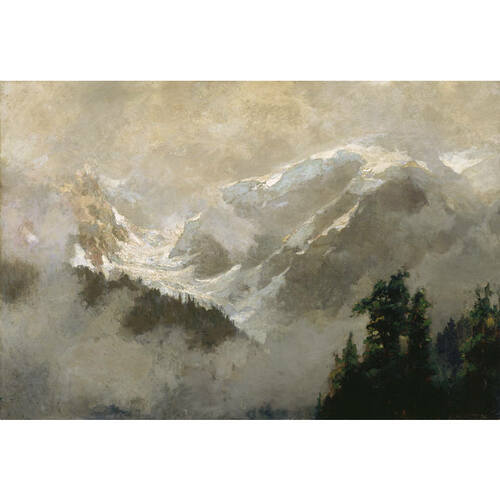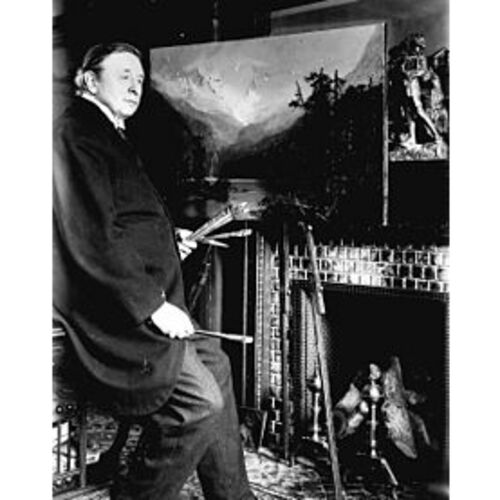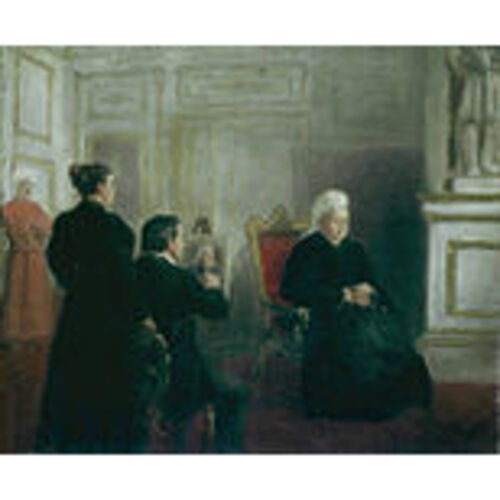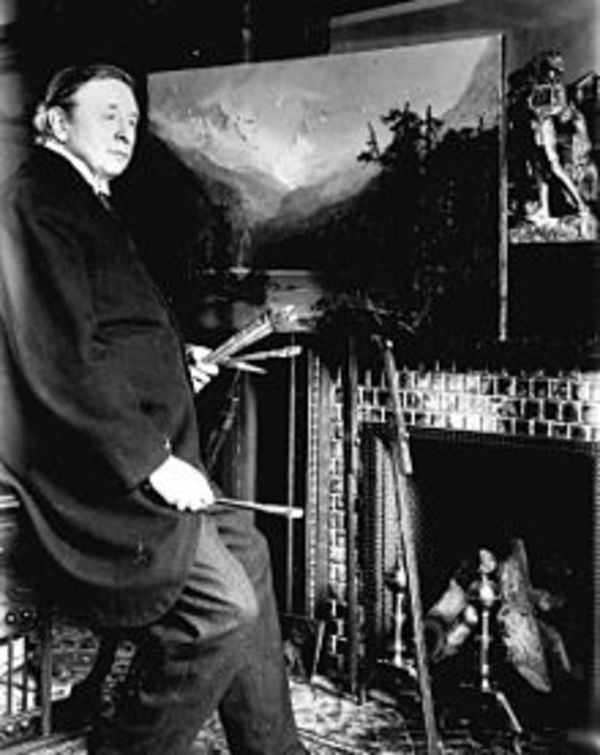
Source: Courtesy of Wikimedia Commons
BELL-SMITH, FREDERIC MARLETT, painter and educator; b. 26 Sept. 1846 in London, England, eldest son of John Bell-Smith and Georgianna Maria Boddy; m. 4 July 1871 Annie Myra Dyde in Montreal, and they had three sons; d. 23 June 1923 in Toronto.
Although recognized primarily as an artist, Frederic Marlett Bell-Smith was a person of wide-ranging interests, equally accomplished as a teacher, photographer, actor, raconteur, and writer. In 1866 his parents emigrated to Canada and settled in Montreal, where Frederic joined them a year later. He was by this time a practising artist, having studied at the South Kensington Art School and with his father, a portrait miniaturist who in London had been secretary-treasurer of the National Institution, a society of painters. In Montreal, where he lived until 1871, the future pattern of Frederic’s career emerged. Showing his characteristic resourcefulness and motivation, he worked for a photographic studio and was a founding member of the Society of Canadian Artists, with his father as president. His first exhibition, at the Art Association of Montreal in 1868, featured urban sports and leisure activities. He also saw action against the Fenians when he served with the Victoria Rifles of Canada in 1870. The following year Bell-Smith, born into the Church of England, married Annie Myra Dyde at the Mountain Street Methodist Church in Montreal, and it may have been around this time that he changed his religious affiliation. The couple then moved to Hamilton, Ont.
For the next ten years the Bell-Smiths lived in Hamilton and Toronto while Frederic expanded his endeavours to include teaching at the Ontario School of Art and freelance illustration for such publications as the Canadian Illustrated News (Montreal) and for what would become Picturesque Canada . . . (Toronto) [see Lucius Richard O’Brien*]. In the meantime he continued his employment in photography and exhibited his work almost yearly; he joined the Royal Canadian Academy of Arts at its founding in 1880 and was appointed academician six years later. This decade was marked by the death in 1881 of Charles Robert, one of the Bell-Smiths’ three sons, and that year the family moved to London, Ont. At Alma Ladies’ College in nearby St Thomas, Bell-Smith was appointed art director and professor of elocution and was soon taken on as drawing master at London’s Central School. He founded the Western Art League, and travelled through Europe and North America on sketching trips. On a subsequent visit to Paris he would study at the Académie Colarossi, and with such artists as Benjamin-Constant, Gustave Courtois, Joseph Blanc, and Edmond-Louis Dupain.
In 1887, thanks to the free Canadian Pacific Railway passes given to artists by William Cornelius Van Horne*, Bell-Smith had the opportunity to fulfil one of his early dreams and see the Rockies. This was a defining moment: for him, reportedly, the mountains forever after “beckoned the enraptured pilgrim to explore their mysteries and their shrines.” Over the next three decades he would visit the Rockies at least eleven times, and such mountain landscapes as The silent sentinel of the north, Heart of the Selkirks, and An ice-crowned monarch of the Rockies became a staple of his output. As an artist, Bell-Smith represented the late-19th-century manner of presenting a subject so as to arouse in the viewer the kinds of emotions evoked by narrative fiction. Working mostly in watercolours and oils, he was popular and prolific, usually producing small, easily marketable pictures meant to grace middle-class homes.
In 1888 Bell-Smith returned to live permanently in Toronto. Until 1890 he served as principal of the Parkdale Art School and then of the Toronto Art School (west end branch). In 1891 he and his wife endured the death of another son, Claude Pelham. Notwithstanding this personal tragedy, Bell-Smith became increasingly successful and was able to make a living wholly from painting. He also started to produce larger compositions, the most celebrated being Lights of a city street, painted in 1894. This crisp, detailed depiction of the corner of King and Yonge in Toronto after the rain captured a moment of urban life, with its streetcars, newsboys, policemen, and well-dressed crowds. In its highly contrasted lights and shadows and deep perspective, the painting shows the artist’s love of photography, both for its ability to arrest time, as well as for its value as a means of documentation. In 1895 the preparatory work for three large history paintings based on the events surrounding the sudden death in England of Sir John Sparrow David Thompson* led to an unprecedented privilege for a North American artist: Bell-Smith was granted a private sitting from Queen Victoria so that he could accurately portray her in one of these works. Ever dramatic, Bell-Smith capitalized on this occasion, writing an article entitled “How I painted Queen Victoria,” where he recalled “a little old lady, very short, and very stout,” with whom he conversed mainly in German.
The early years of the new century were Bell-Smith’s heyday – he retained an administrative association with Alma Ladies’ College from 1897 to 1910 and served as president of Toronto’s New Water Color Society, as well as the Ontario Society of Artists. He also participated in exhibitions in Buffalo, N.Y., Liverpool, and Montreal. As an article in Maclean’s (Toronto) for 1912 observed, his increasingly masterful technique and the aesthetic appeal of his paintings ensured that “‘a Bell-Smith’ has become a necessary adjunct in every collection of importance in the Dominion.”
During the Great War, Bell-Smith painted the activities of the Canadian Expeditionary Force in training at Camp Borden, Ont., and executed a relief map model of the Rockies for the Grand Trunk Pacific Railway. He indulged his abiding passion for acting and dramatic recitations in performances of “habitant” poems, such as those by William Henry Drummond*, and scenes from the novels of Charles Dickens. It was said that he even looked like a Dickens character, and his friends in the Toronto Dickens Fellowship, where he served as president from 1910 to 1920, often debated whether “old Bell” was more gifted as an actor or a painter.
In 1918 Bell-Smith made his last journey to his beloved Rocky Mountains, whose mystic qualities had long captured his imagination. He spent the next summer painting at the Bon Echo Inn, the country home on Mazinaw Lake, Ont., of the theosophist and spiritualist Flora MacDonald Denison [Merrill]. He was probably still painting when he fell in the basement of his Toronto home in May 1923. He died the next month. A memorial exhibition of his work was held in Toronto and in 1928 Bell-Smith’s painting of Mount Hurd, B.C., was reproduced on a Canadian 10-cent stamp. Bell-Smith combined energy, creativity, and salesmanship with an awe for nature as an example of God’s legacy to human resourcefulness.
F. M. Bell-Smith is the author of Little Nell: adapted from “The old curiosity shop” of Charles Dickens (Toronto, [1909?]).
Roger Boulet’s biography, Frederic Marlett Bell-Smith, 1846–1923 (Victoria, 1977), is the most comprehensive account available about Bell-Smith. Well-researched and abundantly illustrated with reproductions of paintings as well as family photographs, it contains a lengthy bibliography, a list of Bell-Smith’s principal exhibitions during his lifetime, and a chronology. A collection of catalogues and newspaper and magazine clippings, some, but not all, of which are cited individually in Boulet, can be found in the National Gallery of Canada Library (Ottawa), Artist file, Bell-Smith, F. M.
ANQ-M, CE 601-S105. AO, F 1140. Paul Gessell, “A treasure is rediscovered: historic painting depicts former PM’s state funeral,” Ottawa Citizen, 26 Oct. 1998. Canadian men and women of the time (Morgan; 1898 and 1912). A dictionary of Canadian artists, comp. C. S. MacDonald (7v. to date, Ottawa, 1967– ). Standard dict. of Canadian biog. (Roberts and Tunnell), vol.2. Winnipeg Art Gallery, 150 years of art in Manitoba: a struggle towards a visual civilization; a Winnipeg Art Gallery exhibition commemorating Manitoba’s centennial, May 1–Aug. 31, 1970, comp. B. L. Pitman and Hanspaul Hager ([Winnipeg, 1970]).
Cite This Article
Molly Pulver Ungar and Vicky Bach, “BELL-SMITH, FREDERIC MARLETT,” in Dictionary of Canadian Biography, vol. 15, University of Toronto/Université Laval, 2003–, accessed April 12, 2025, https://www.biographi.ca/en/bio/bell_smith_frederic_marlett_15E.html.
The citation above shows the format for footnotes and endnotes according to the Chicago manual of style (16th edition). Information to be used in other citation formats:
| Permalink: | https://www.biographi.ca/en/bio/bell_smith_frederic_marlett_15E.html |
| Author of Article: | Molly Pulver Ungar and Vicky Bach |
| Title of Article: | BELL-SMITH, FREDERIC MARLETT |
| Publication Name: | Dictionary of Canadian Biography, vol. 15 |
| Publisher: | University of Toronto/Université Laval |
| Year of revision: | 2005 |
| Access Date: | April 12, 2025 |


